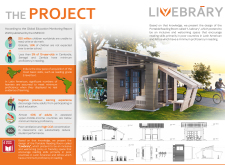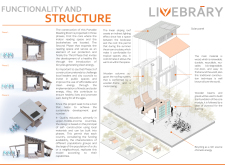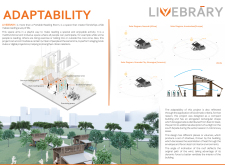5 key facts about this project
### Overview
Livebrary is a Portable Reading Room designed to address global literacy challenges, particularly in underserved regions of Latin America and Africa. This multifunctional space aims to foster literacy and community engagement in locations where access to educational resources is limited. The architecture prioritizes sustainability and community involvement, creating an environment conducive to learning and collaboration.
### Spatial Layout and Functionality
The Livebrary features a tiered design comprising three main phases. The first phase establishes a core indoor reading space with integrated bookshelves. The second phase expands this reading area while incorporating elements designed for sun protection. The third phase promotes healthy living by introducing activities such as cycling, which generates clean energy. The layout is characterized by an open configuration that facilitates simultaneous activities in a defined space, promoting interaction across different user groups.
### Material Selection and Sustainability
The primary material utilized in the construction of Livebrary is wood, chosen for its renewability, durability, and low environmental impact. Secondary materials include wooden beams for structural support, gravel for foundational stability, plywood for flooring, and metal casing for structural integrity. These materials were selected considering their low carbon footprint and adaptability to diverse locales, allowing for self-construction in varying environments.
Integration of solar panels enables energy autonomy, enhancing sustainability and operational feasibility in remote areas with limited electricity access. Additionally, mechanisms for energy generation through bicycles align with the project's emphasis on both sustainability and promoting active lifestyles.





















































